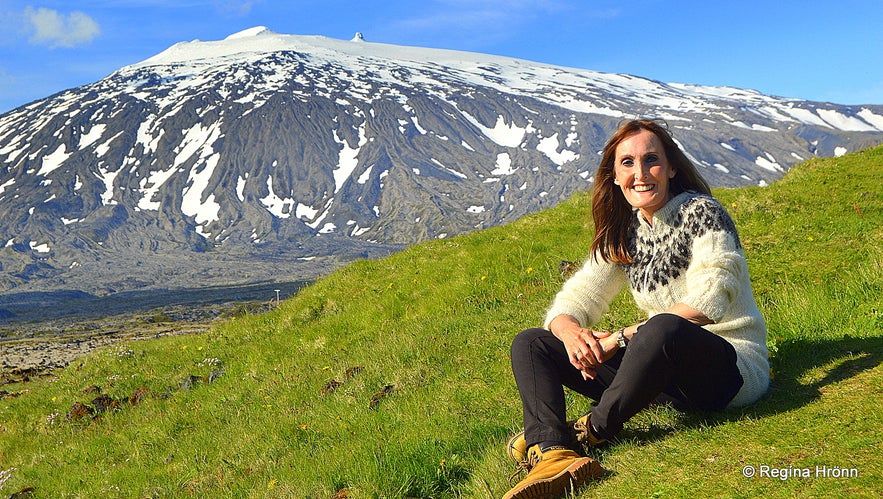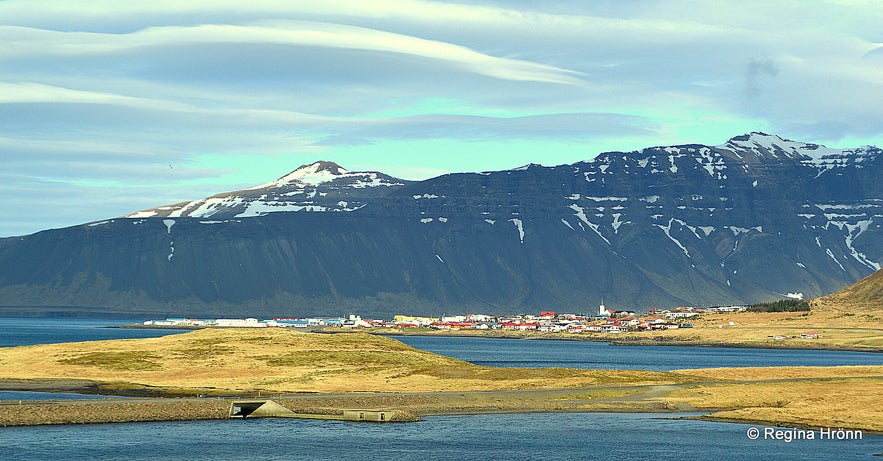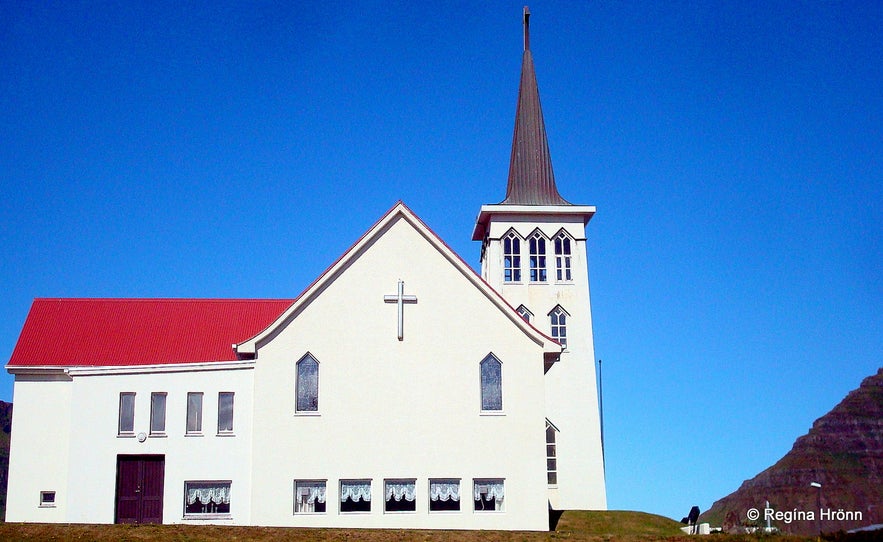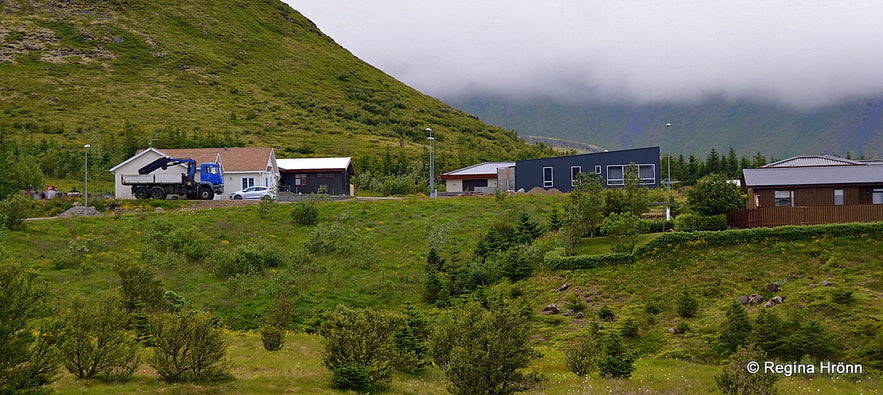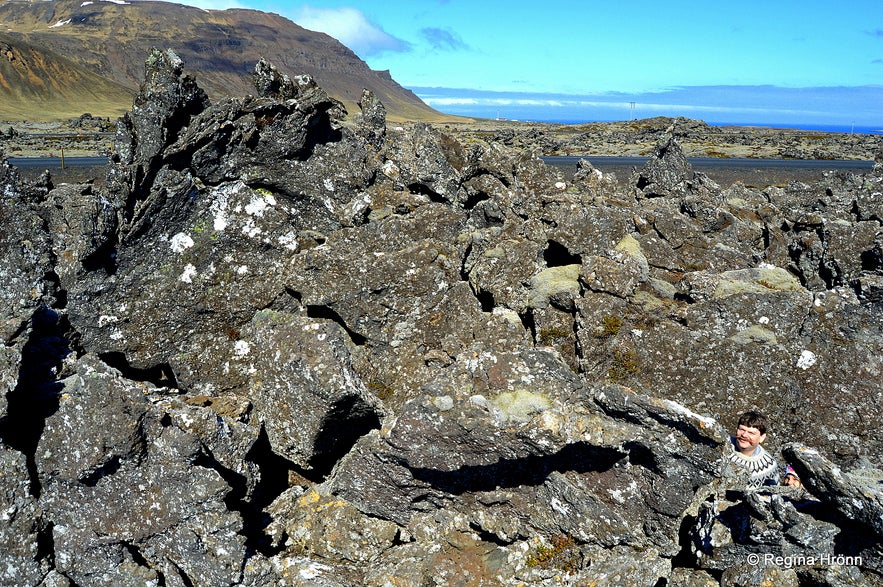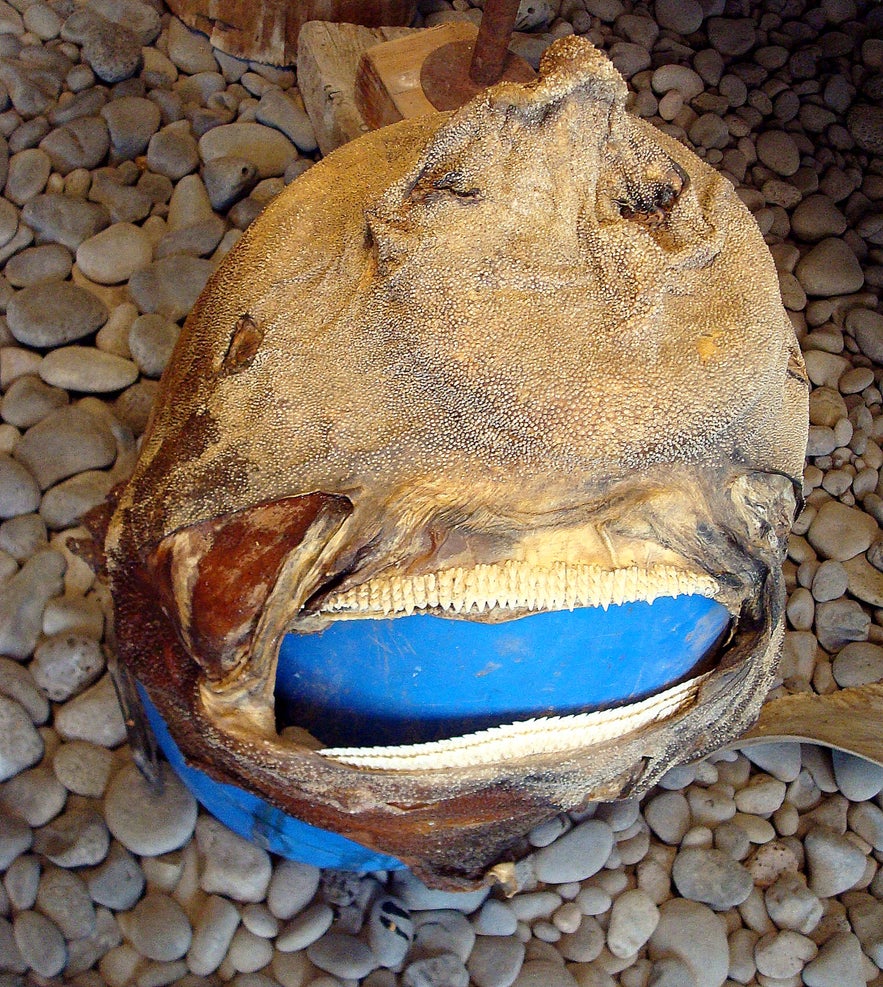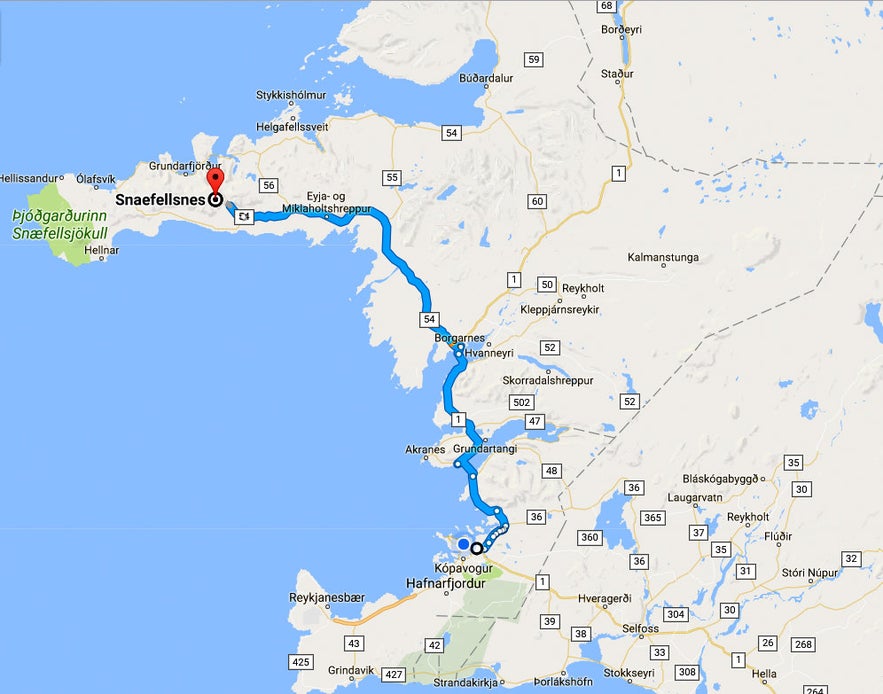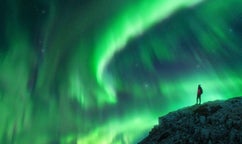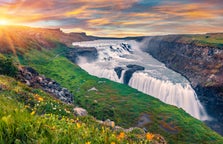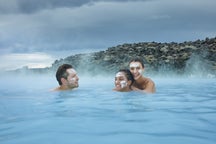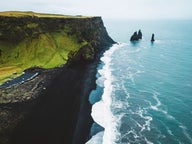This is part IV in my series of travel-blogs about the magical Snæfellsnes peninsula, in which I show you the most interesting places on the peninsula in chronological order.
There is so much to see and do here on the peninsula, that I have had to add 5 travel-blogs with several side-blogs.
Top photo: By Snæfellsjökull glacier
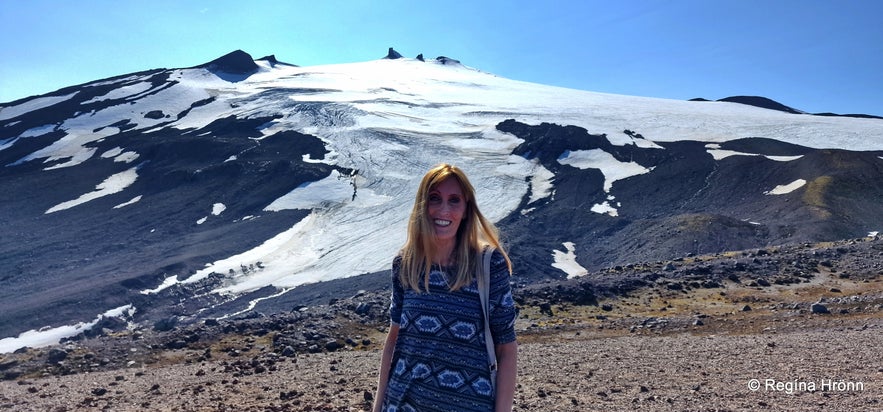 By the roots of Snæfellsjökull glacier
By the roots of Snæfellsjökull glacier
I hope that this travel-blog style guide will prove helpful in introducing my favourite peninsula in Iceland to you and that you will be able to enjoy it better when you visit it yourself.
If you want to start travelling with me from the beginning, then you can do so by reading the Magical Snæfellsnes Peninsula part I, then the Magical Snæfellsnes Peninsula part II, and finally the Magical Snæfellsnes Peninsula part III.
The view from the roots of Snæfellsjökull glacier, the landmark of the peninsula
In my last travel-blog, we travelled from Gufuskálar to Ólafsvík and are by now leaving that town and driving further on Útskálavegur road number 574 until we finally merge with the main road number 54 just a little further on.
Mt. Kirkjufell in Grundarfjörður
Mt. Kirkjufell in Grundarfjörður
Mt. Kirkjufell (463 m) is the best-known mountain in Grundarfjörður and a landmark of this fishing village.
The mountain is referred to as being the most beautiful mountain on the Snæfellsnes peninsula, and sometimes it is even referred to as being the most beautiful mountain in Iceland. At least it is the most-photographed mountain in Iceland.
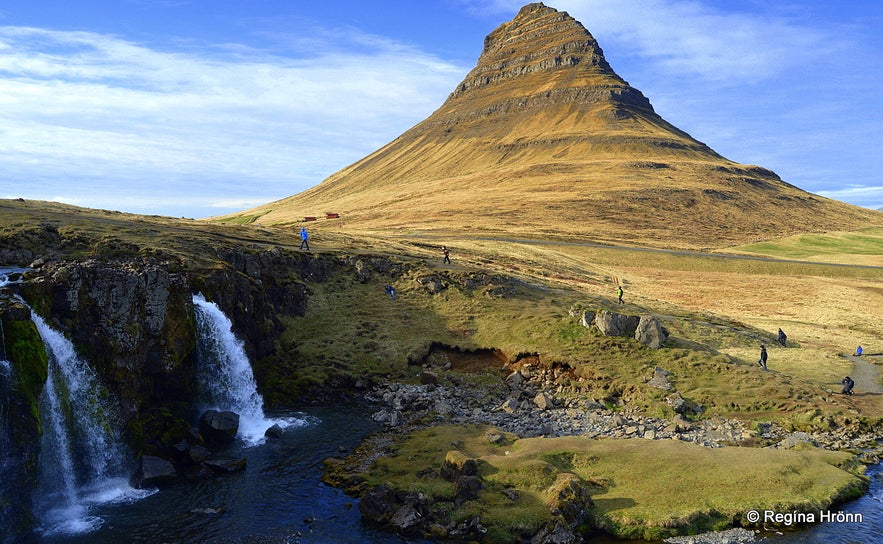
Mt. Kirkjufell and Kirkjufellsfoss waterfall in Grundarfjörður
The name Kirkjufell means Church Mountain - it is considered to resemble a church as it is freestanding and majestic.
Mt. Kirkjufell and Kirkjufellsfoss waterfall have become the most popular photo stop here in Grundarfjörður, and sometimes it can get very crowded by the waterfall when everybody is trying to get the exact same photo of the mountain with the waterfall in front.

On the bench admiring Mt. Kirkjufell
The name of the river is Kirkjufellsá river, and it creates 3 waterfalls, which all bear the same name - Kirkjufellsfoss.
In my photos above and below, you can see my favourite angle of Mt. Kirkjufell, the bench in Grundarfjörður, and the popular Mt. Kirkjufell in the distance.
You can read up on this location in my Kirkjufellsfoss waterfall travel-blog.

Admiring Mt. Kirkjufell
I have written a special travel-blog which I dedicated to Mt. Kirkjufell & Kirkjufellsfoss waterfall, where I have included many more photos and information, including why you should not climb this mountain.
Grundarfjörður village
Grundarfjörður village as seen from afar
I took this photo above of Grundarfjörður from Kirkjufellsfoss waterfall. There is a popular hiking trail from the village to Kirkjufellsfoss waterfall.
It is a beautiful and easy walk, and by walking to Kirkjufellsfoss, you don't have to pay for parking by the waterfall.
Admiring Mt. Kirkjufell and Grundarfjörður fjord by the sea in the village
As with other villages and towns on the Snæfellsnes peninsula, fishing is the main industry in Grundarfjörður, but tourism is a growing industry as well, and there are a lot of organized trips and things to do here.
The population of Grundarfjörður is around 900. The Information Centre in Grundarfjörður is located at the Grundarfjörður Heritage Centre - Sögumiðstöðin, where you will also find a café, a library, and a couple of small exhibitions depicting the changes in Grundarfjörður's history and technology through the centuries.
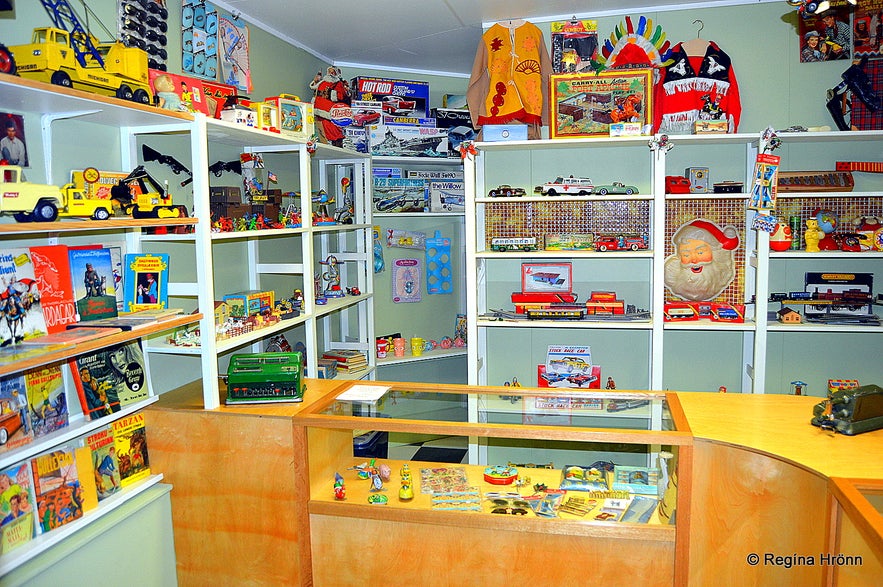
Eyrbyggja Heritage Centre museum - Sögumiðstöðin - Þórðarbúð
And you will even find an old French cannon at one of the museums.
I especially like the exhibition of the replica of an old shop, Þórðarbúð from the fifties, and I always pop in for a visit when I visit Grundarfjörður. Þórðarbúð shop was a normal convenience store run by Þórður Pálsson.
There is just something so friendly and appealing about such old toys, don't you agree?
By the exhibition, you will find a children's play area where they can even play with the toys of olden times, animal jaws, horns, and leg bones.
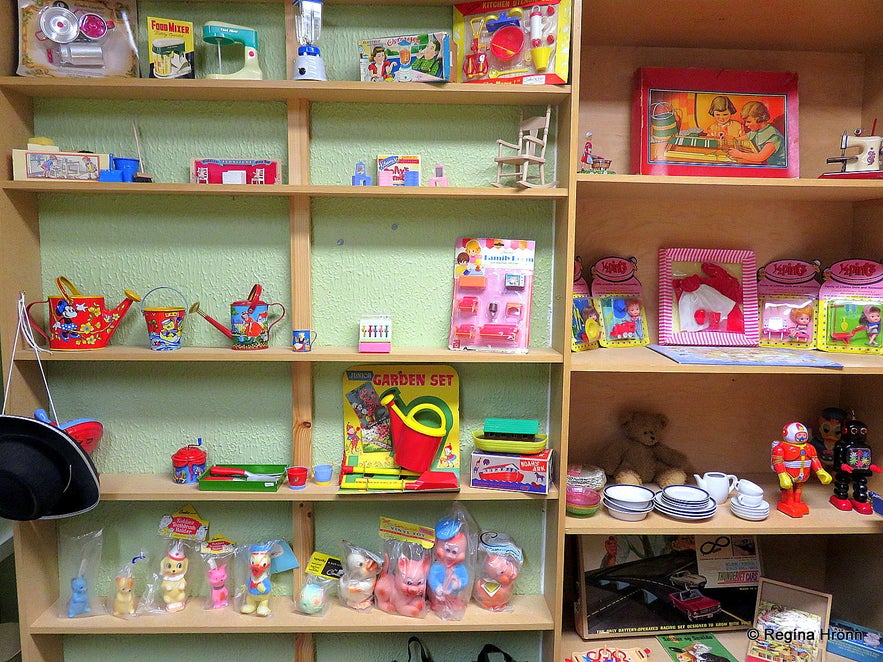
Þórðarbúð
Also, don't miss visiting Bæringsstofa, which is a photo gallery where you can sit down and watch a slide show about life in Grundarfjörður through the ages.
These photos belong to the photographic gallery of Bæring Cecilsson (1923-2002), who donated his gallery to Grundarfjörður.
I am very grateful to the Information centre, as once when I desperately needed an auto mechanic, the girl at the Information Centre phoned several mechanics and found one for me in Stykkishólmur, the largest town on the Snæfellsnes peninsula. Such personal help is always greatly appreciated, especially when one is travelling.

My husband by the cannon
Now, let's get back to the cannon I mentioned - on display is one of two cannons that were unearthed on the Kirkjufell shore sand.
These two cannons come from a stranded whaler from France, which stranded here in 1720. Grundarfjörður has a special bond with the French and is twinned with Paimpol in France.
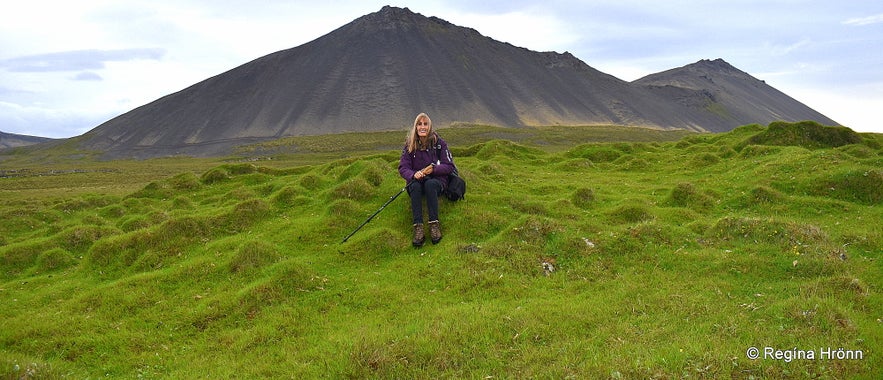 By old ruins at Öndverðareyri
By old ruins at Öndverðareyri
Sunna Njálsdóttir, who works at the library, was very helpful when I needed some information about old Viking ruins at Öndverðareyri :)
Sunna is the sister of Marteinn at Suður-Bár and Gunnar, whom I mention a little further on in this travel-blog.
She told me that she had read my travel-blog, which warmed my heart, as I never know who reads my travel-blog :)
Grundarfjarðarkirkja church
Grundarfjarðarkirkja church
Grundarfjarðarkirkja church is a big church (Iceland style), in Grundarfjörður, which was consecrated in 1966.
It has been blessed with the gifts of many benefactors of the church, who have given artifacts to the church in remembrance of loved ones.
Almost everything inside Grundarfjarðarkirkja has been donated to the church by friends and benefactors.

The altar and altarpiece in the Grundarfjarðarkirkja church
The church in Grundarfjörður is especially dear to me as the two beautiful stained windows by the altar were donated to the church by my grandfather and his children.
And my favourite, the beautiful stained glass window in the back of the church, depicting Jesus blessing the children, was donated to the church in remembrance of my grandfather by his children.
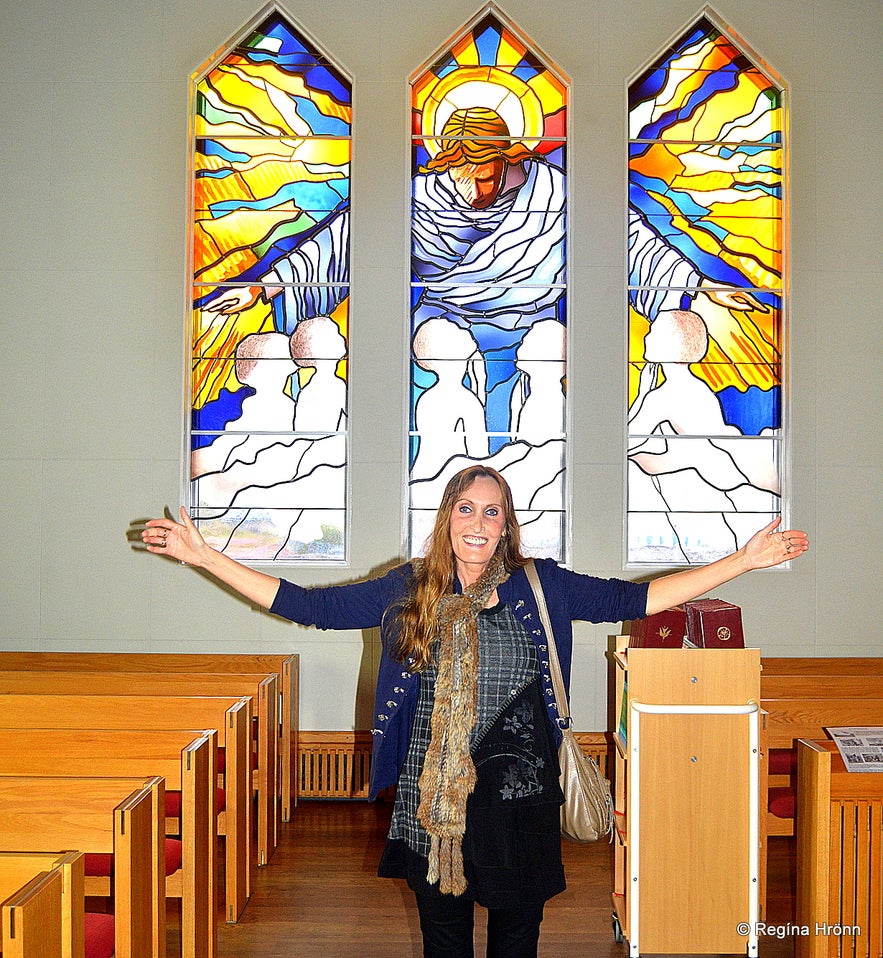
Inside the Grundarfjarðarkirkja church in front of the stained glass window
My grandfather, Kjartan, was born at Fróðá and raised in Grundarfjörður on the farm Grund and on the lovely farm Suður-Bár.
Both Grund and Suður-Bár offer accommodation in Grundarfjörður, and I have stayed in both these places, and can recommend them both. They are especially dear to me due to the family ties I have to them.
Elves and dwarfs in Grundarfjörður
Elf-locations in Grundarfjörður
Grundarfjörður got the Green Globe certification for environmental standards, and it is probably the only village in the world where the building authorities have donated a special allotment to the Hidden people of Iceland.
In my photo above, you will see the allotment (Fellasneið 3) dedicated to the elves or hidden people of Iceland. It is to the left in the photo, and there will never be a house built there as it is already occupied by the hidden people.
I visited it and found several large rocks at the top of the hill.
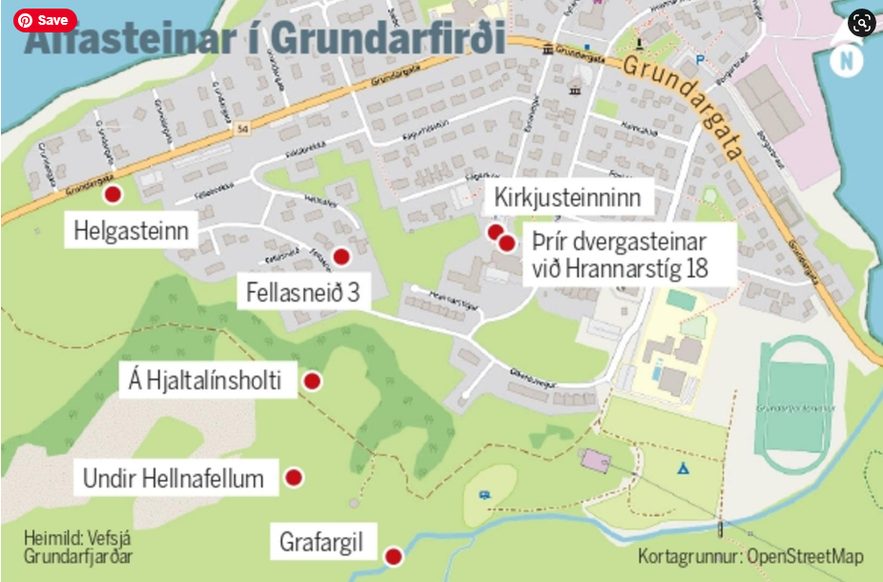
According to an article I read in Morgunblaðið, our morning paper, about the hidden people in Grundarfjörður, the medium Gunnar Njálsson, who lives in Grundarfjörður, was told that there were plans to build a house on this allotment.
He went to talk to the hidden (to most of us) inhabitants and saw a young woman sitting on a rock, crying. She was dressed in a beautiful blue and white dress.
She told him that she was sad, as there were plans to build a house on top of her "hidden house".
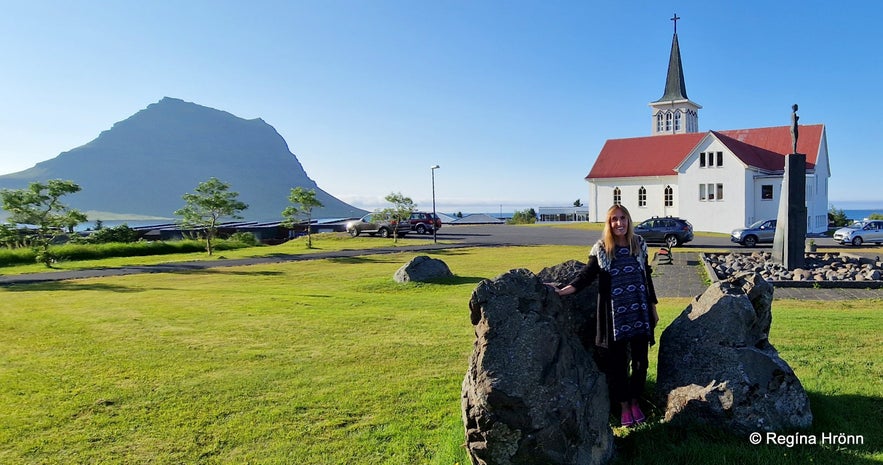 Dwarf rocks and Mt. Kirkjufell
Dwarf rocks and Mt. Kirkjufell
He assured her that he would tell the mayor of Grundarfjörður about her predicament.
And the plans for building on this allotment were stopped.
That is what we Icelanders do when we hear that hidden people are living where we plan to build or put a new road, as we want to live in harmony with these hidden people who inhabit Iceland with us.

A dwarf rock by Grundarfjarðarkirkja church - and the artwork Sýn by Steinunn Þórarinsdóttir
You will find several elf rocks in Grundarfjörður and even rocks with dwarfs living in them. One such rock is close to the church.
According to Gunnar Njálsson, the medium, who is the brother of Sunna at the library, and Marteinn at Suður-Bár, a boy, who lives close to the church, was cycling by the rock and accidentally hit it, so both he and the bike fell down.
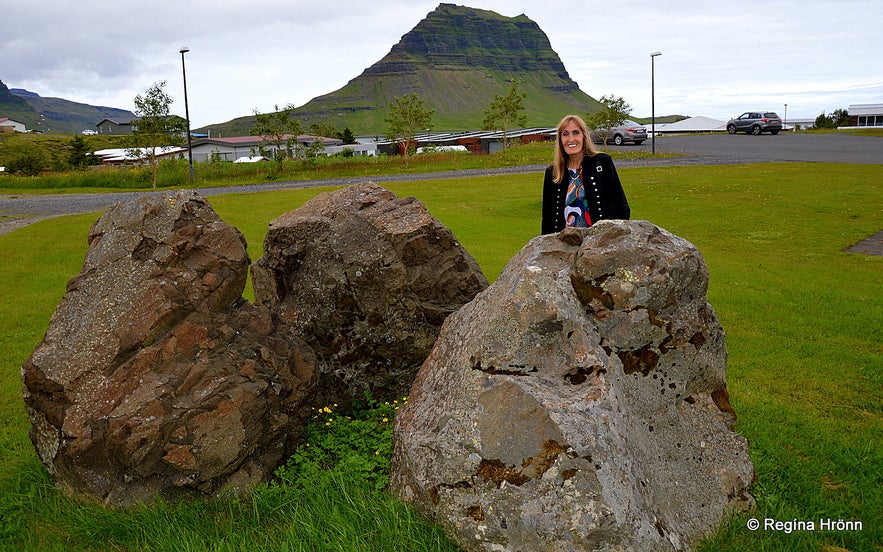
Three merry dwarfs live in these 3 rocks
He stood up and took the bike, and walked with it away from the rock. He looked back and saw an angry little man, a dwarf, who scolded him for hitting his home.
He then saw the dwarf disappear into the rock again. The dwarf was dressed in brown and wearing black boots. And he had a red cap with a tassel on his head (skotthúfa).
In the interview with Gunnar (in Icelandic), he also told us about the 3 rocks by the church. They are also the habitation of dwarfs.
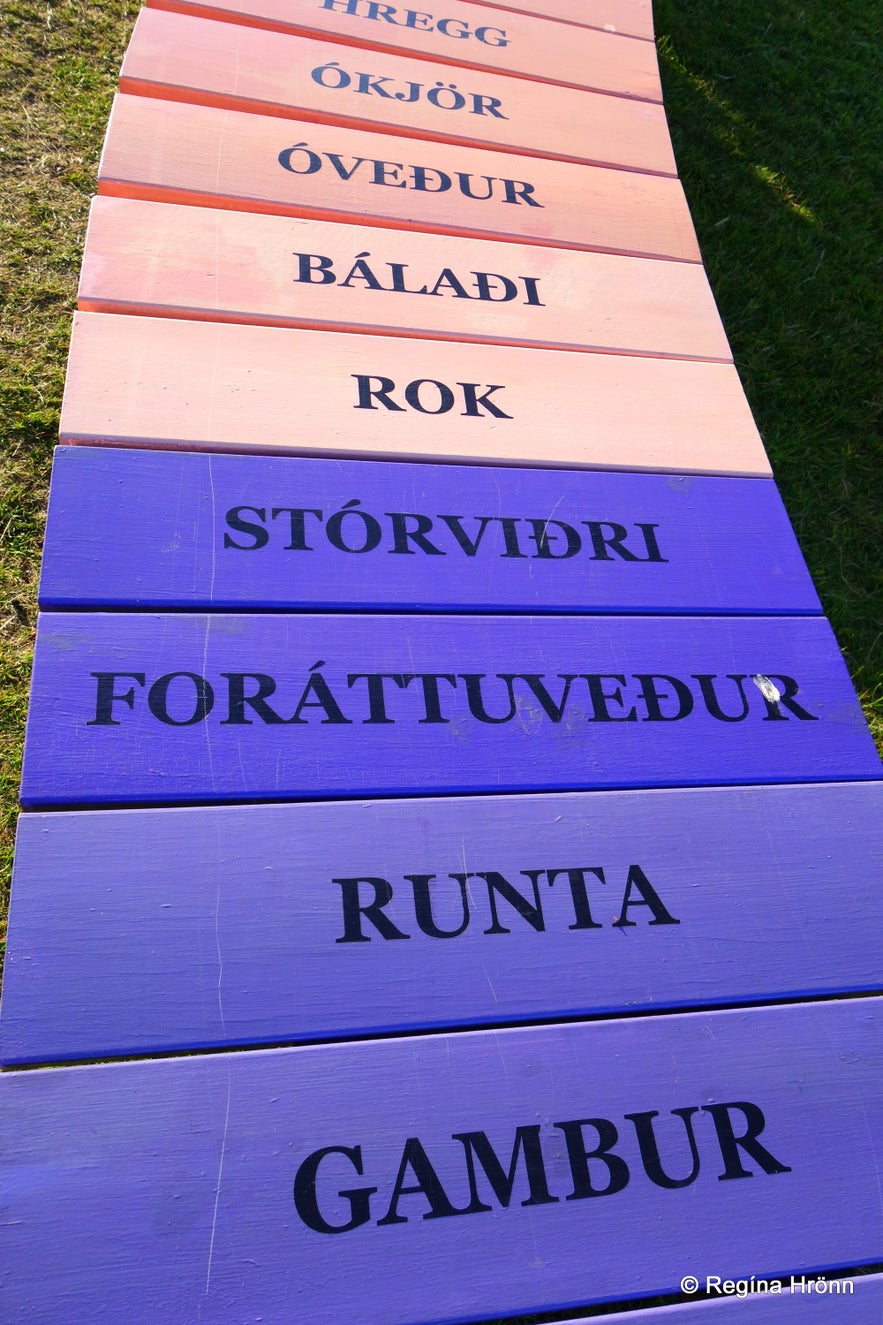 The artwork called Veðurhorfur is close to the church - 112 words meaning wind in Icelandic
The artwork called Veðurhorfur is close to the church - 112 words meaning wind in Icelandic
An interesting story that happened to Gunnar himself. He was working for the community and put 3 large rocks from the quarry in front of the retirement home.
While he was raking the grass around the rocks, he saw 3 dwarfs running toward him with their belongings.
They merrily asked him if he would allow them to live in the rocks.
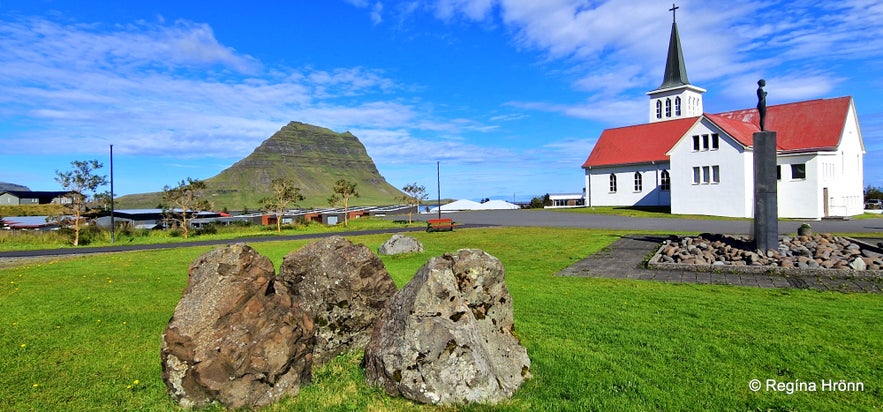 The 3 dwarf rocks
The 3 dwarf rocks
Gunnar, of course, allowed them to do so :) And they are still living in the rocks, according to Gunnar.
Suður-Bár guesthouse
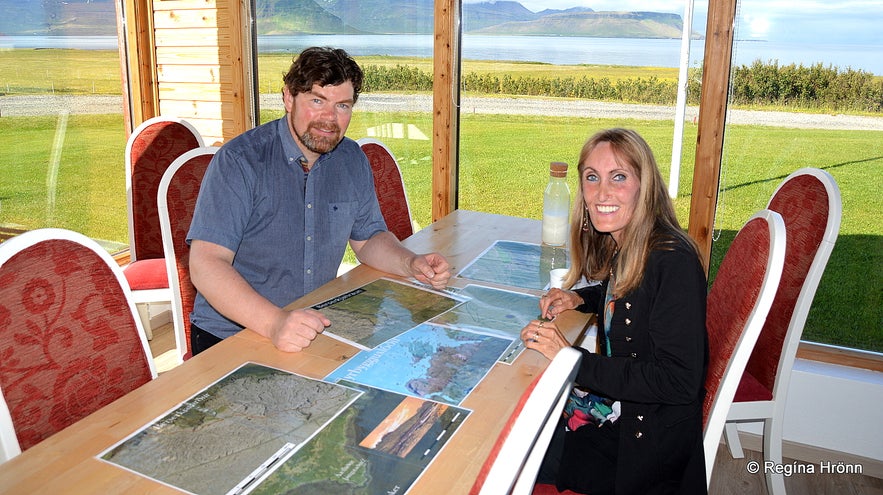
Marteinn at Suður-Bár showed me maps with invaluable information about this area
It must be amazing being able to see elves, the hidden people, and dwarfs! I would love to meet Gunnar one day and talk to him.
This video was sent to me by his brother, Marteinn, who runs a travel service at Suður-Bár in Grundarfjörður, where my grandfather once lived until his father drowned.

Suður-Bár guesthouse
I stayed at Suður-Bár for one night to get acquainted with my grandfather's former home and got a lot of valuable information from Marteinn, which I am very grateful for.
Thank you, Marteinn, for your help :)
Such friendly and knowledgeable siblings.
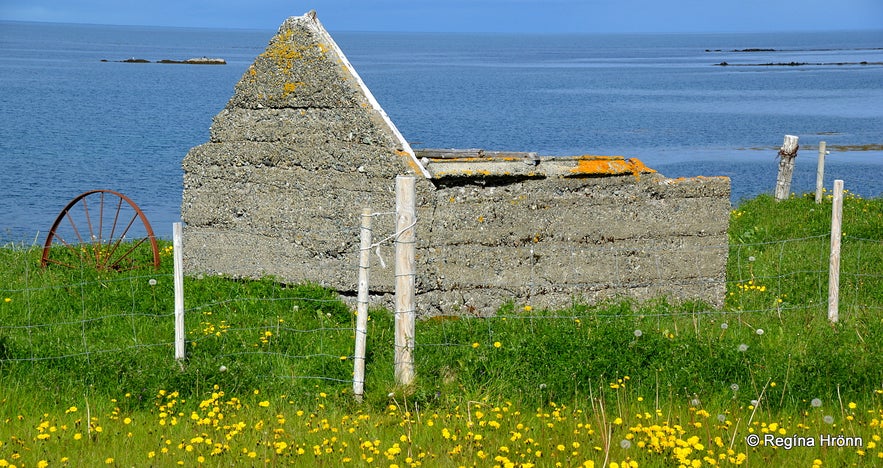
In the bay outside Suður-Bár farm, my great-grandfather drowned back in 1919
It was on the 31st of January 1919, when my grandfather, Kjartan Ásmundsson, was 15 years old, that his father, Ásmundur Sigurðsson, drowned in Grundarfjörður just outside Bár, where they lived.
His older brother, Einar, and another man survived, but 5 men drowned on this day. Ásmundur's second wife, Kristín, moved to Hamrar in Grundarfjörður with her children after the death of her husband.
My grandfather, who was in his teens, had to move away from Grundarfjörður. He became a goldsmith in Reykjavík's oldest street, Aðalstræti.

My grandfather Kjartan Ásmundsson
His brother, Einar, who survived the accident at sea, went to study iron making and later established the big company Sindrastál in Reykjavík.
Their sister, Jakobína, who was 14 at the time their father died, later on, established a tie factory, Hálsbindagerðina Jaco, in Reykjavík, which she ran for almost 40 years.
So the siblings did well after losing their father and having to move away from their home in Grundarfjörður in their teens.

With my relative Kristinn at Kverná, my father's cousin, back in 2008 by the graves of our relatives
I have relatives living in this area, the sons of my grandfather's sister at Kverná farm in Grundarfjörður. They also offer accommodation at Kverná - Skjólsteinar.
Grundarfjörður was always very dear to my grandfather, and we visited this area with him, and the grave of his father, brother, and grandparents when I was little.
Fond memories and this fjord will always be very dear to me.
 Visiting the graves of my ancestors in Setbergskirkjugarður on a family trip in 1966 to Grundarfjörður
Visiting the graves of my ancestors in Setbergskirkjugarður on a family trip in 1966 to Grundarfjörður
And I am happy that I still have relatives living in Grundarfjörður, and I knock on their door every time I visit this area. I hope they are not too bored of me ;)
Staying at Grund guesthouse
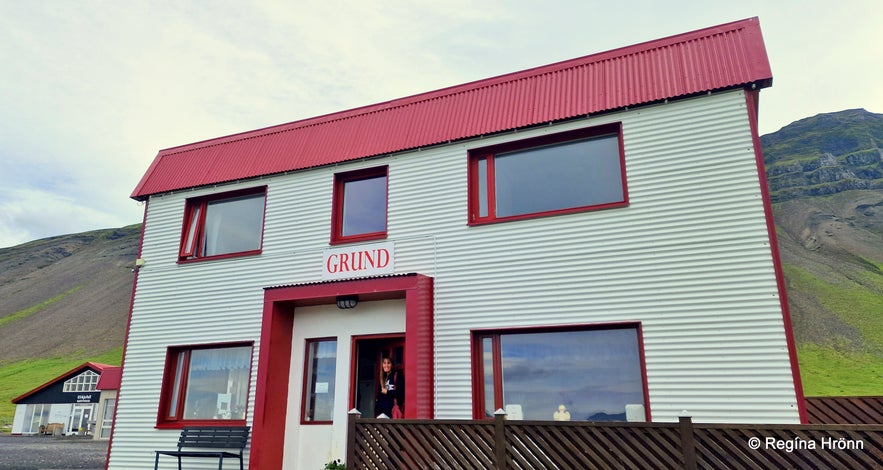 Grund guesthouse
Grund guesthouse
On one of my visits recently, to Grundarfjörður, I booked a room at Grund guesthouse.
I had always wanted to visit Grund as my grandfather lived here from age 1-10 before his family moved to Suður-Bár, and I have a photo of my father playing outside of Grund when he was a little boy.
So when I saw that they offer accommodation at Grund, I told my husband that I wanted to extend our trip and stay at Grund.
 The Grundará river runs by Grund - Grundarfoss waterfall in the distance
The Grundará river runs by Grund - Grundarfoss waterfall in the distance
We were coming from the Westfjords and arrived in Grundarfjörður in an unprecedented storm and heavy rain, which had made the rivers swell so much that they flooded the fields, and the waterfalls were huge.
So we stayed inside, which I was happy to do, as it is not every day that I get to sleep in the house where my great-grandparents once lived. The current house was built around the house where my grandfather lived.
 Our room at Grund guesthouse
Our room at Grund guesthouse
The view from our room was so lovely and we could see Grundarfoss waterfall in the distance.
The next day, I went on an exploration of the surroundings and had a very informative chat with the very knowledgeable Ingi Hans, who works at Grund from 9-10 in the morning.
Ingi Hans is a well of information, so do chat with him during these hours if you are staying at Grund and need information about Grundarfjörður, or you just want an entertaining chat :)
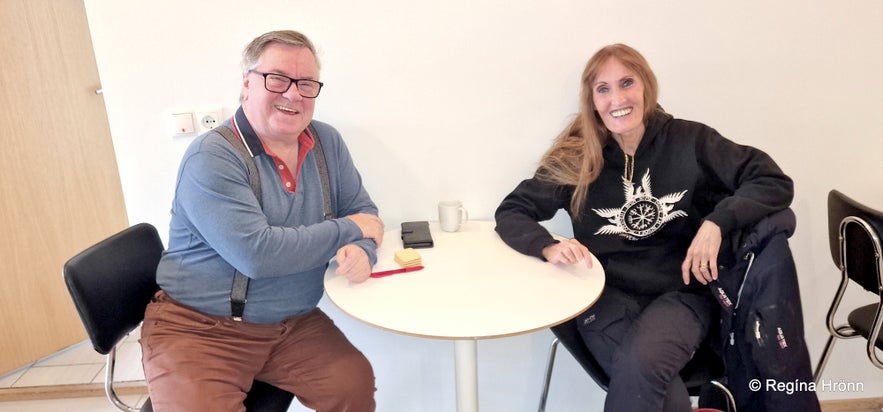 Chatting with Ingi Hans at Grund guesthouse
Chatting with Ingi Hans at Grund guesthouse
What a lovely visit this was, I felt energized and happy after my stay in Grundarfjörður.
Do stay here in this village if you can, either at Grund, Suður-Bár, or at Staksteinar - Kverná. There is more accommodation in Grundarfjörður, but I have only stayed in these 3 guesthouses and one apartment for rent, Guesthouse María at Hrannarstígur 3, and can recommend them.
Check out: Accommodation on the Snæfellsnes peninsula.
Vikings in Grundarfjörður
Vikings in the Viking club Glæsir in Grundarfjörður
You will find a Viking club in Grundarfjörður called Glæsir, which is one of 9 Viking clubs in Iceland. The first Viking club, to my knowledge, was founded in 1997 in Hafnarfjörður, the home of the Viking Village.
I have visited Grundarfjörður during their town festival and witnessed a Viking fight by two Vikings.
I seek out Viking activities in Iceland and have written a special travel-blog: The Icelandic Vikings - a List of Viking Activities in Iceland today, which I have joined

Vikings in the Viking club Glæsir in Grundarfjörður fighting at the town festival
Grundarfjörður is by road 54 on the north coast of the Snæfellsnes peninsula - 185 km from Reykjavík. Here you can see the exact location of Grundarfjörður on the map.
Kvernárfoss & Grundarfoss waterfalls
Here I am in the photo on the other side of the Kvernárgljúfur gorge with special permission from my relatives at Kverná.
You will find 2 lovely waterfalls close to Kverná farm on the outskirts of Grundarfjörður, called Kvernárfoss and Grundarfoss waterfalls.
In the gorge by Kvernárfoss, it is believed that you will find the biggest concert hall of the elves in Iceland!
I got special permission to visit it from my relatives, but the elves in the gorge do not want to be disturbed.
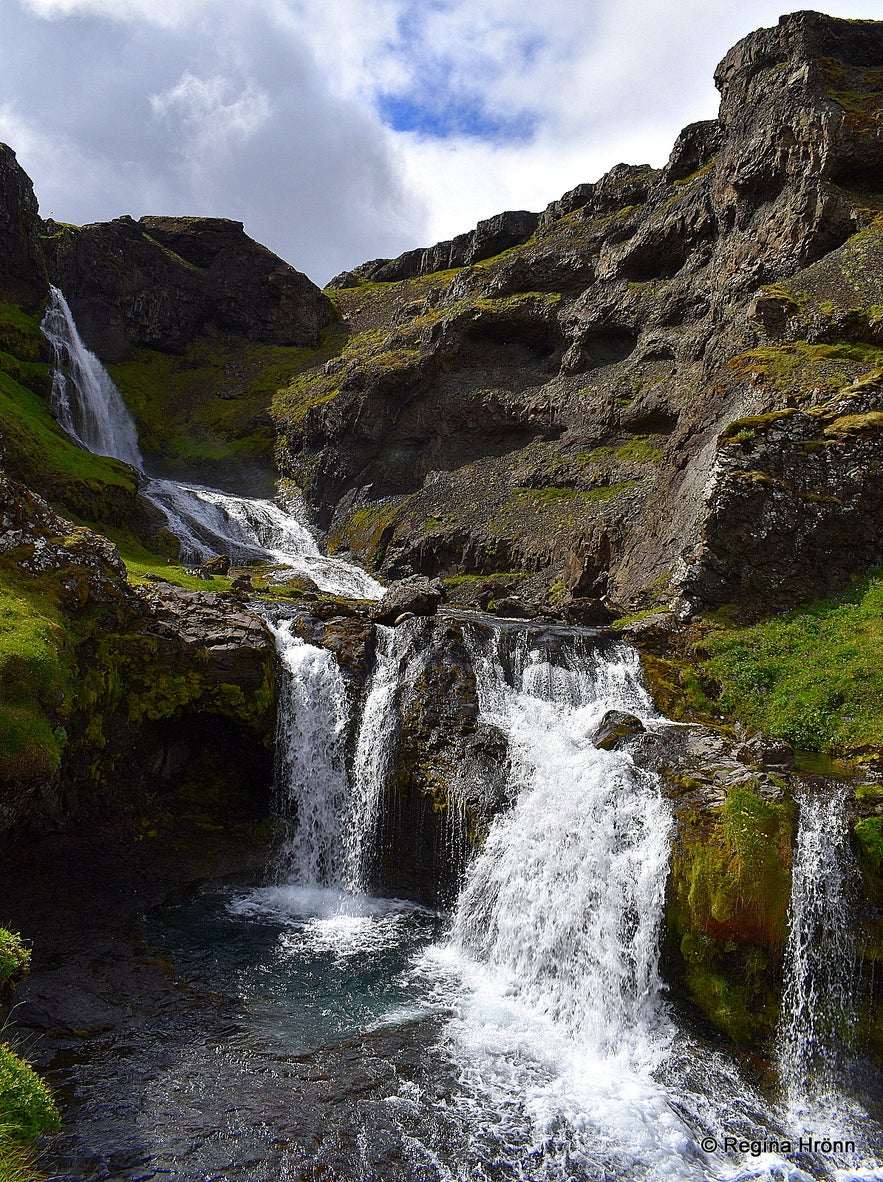
Beautiful Kvernárfoss waterfall
You can read much more in my travel-blog about Kvernárfoss waterfall: The Concert Hall of the Elves, where I tell you about the hidden people a medium saw in the gorge, how the women were dressed, and what they were like.
And the gift they gave to me...
The other waterfall, Grundarfoss waterfall, is 70 meters high and falls into the river of Grundará. You can hike up to Grundarfoss, you will reach the waterfall in approx. 15 minutes.
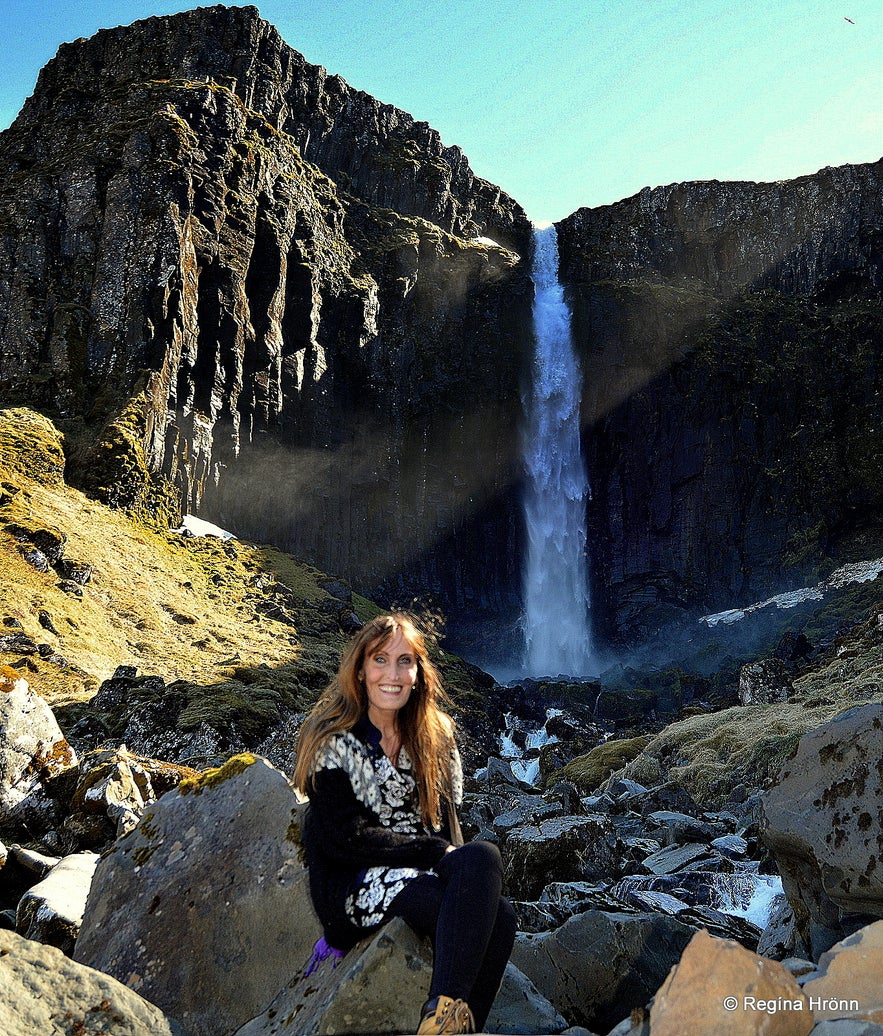
Grundarfoss waterfall
I have often admired this majestic waterfall from afar and only once hiked up to it.
There is something mystical about Grundarfoss waterfall, something about the way it plummets into the gorge. To me, it looks very majestic, and it is well worth going on this short hike to be able to stand right next to it.
Here you will see the location of Grundarfoss waterfall on the map.
Now let's keep on driving along Road 54 to our next destination, the Berserkjahraun lava field.
Berserkjahraun lava field and Berserkjagata trail
My husband in the lava field
There are several lava fields on the Snæfellsnes peninsula, as those of you who have joined me on my trip around the peninsula have noticed.
One such lava field is called Berserkjahraun or Berserk lava on the northern side of the Snæfellsnes peninsula.
The Viking Saga, which happened in this area, is told in the Eyrbyggja Saga. It is a long story, but a very short version of the story is that two berserks from Sweden, Halli, and Leiknir, were killed here and buried by Víga-Styr the Slayer after the berserks made a bridle path through the rugged lava field on his demand.

Walking on the Berserkjagata trail in the dusk
This travel-blog is getting to be so long as there is so much to see and do here, that I created a side blog about the Berserks who created the Berserkjagata trail:

Now, let's visit the Shark Museum at Bjarnarhöfn and turn left from Road 54 by the shark sign and onto a road called Helgafellssveitarvegur.
Drive for a short distance and turn left on the road leading to the museum.
The Shark Museum at Bjarnarhöfn
Just follow the shark sign
It is not every day that one sees a sign in the shape of a shark. This sign points you in the direction of the privately-owned Shark Museum at Bjarnarhöfn - Hákarlasafnið in Icelandic, which is a must-see. At this museum, you will learn about the history of the farm, shark hunting, and shark curing.
There is/was a tradition here in Iceland to eat sharks. It is either hunted or gets entangled in the nets of fishermen. The shark meat is poisonous, so it has to be processed. The meat is buried in a pile in crates and allowed to ferment for 6-8 weeks.
Then it is hung up for 4 months. It is fermented during the wintertime when it is cold outside and hangs up during the summertime.

Shark jaws
After the processing, the shark is frozen. I wonder who was the first one willing to try the meat after it had been processed; somebody must have died after trying to eat the fresh meat.
The Icelandic term for a shark is hákarl, and for a rotten shark, it is kæstur hákarl. Just so you know that if an Icelander offers you kæstur hákarl, then you know what you are in for.
The taste is very strong and can make your eyes water, so it is often eaten together with dried fish and the Icelandic brennivín aquavitae.
The owner of the Shark Museum, Hildibrandur, and his sons gave you a warm welcome. Hildibrandur processed Greenland sharks at his farm, Bjarnarhöfn, for over 65 years.

My husband in the jaws of a shark
Once my husband and I entered the museum just after closing time, as we wanted to have a look at the church at Bjarnarhöfn and we were asked if we could come back later.
A bit difficult as we were driving back to Reykjavík that same night. Hildibrandur was getting on in years and was tired after greeting visitors all day long.
I hated troubling Hildibrandur when he was tired, but my husband, who is a professional magician, put on a small magic show for Hildibrandur and his sons and meant to leave.
These friendly people saw pity on us and showed us around - very much appreciated. Hildibrandur passed away in November 2017.
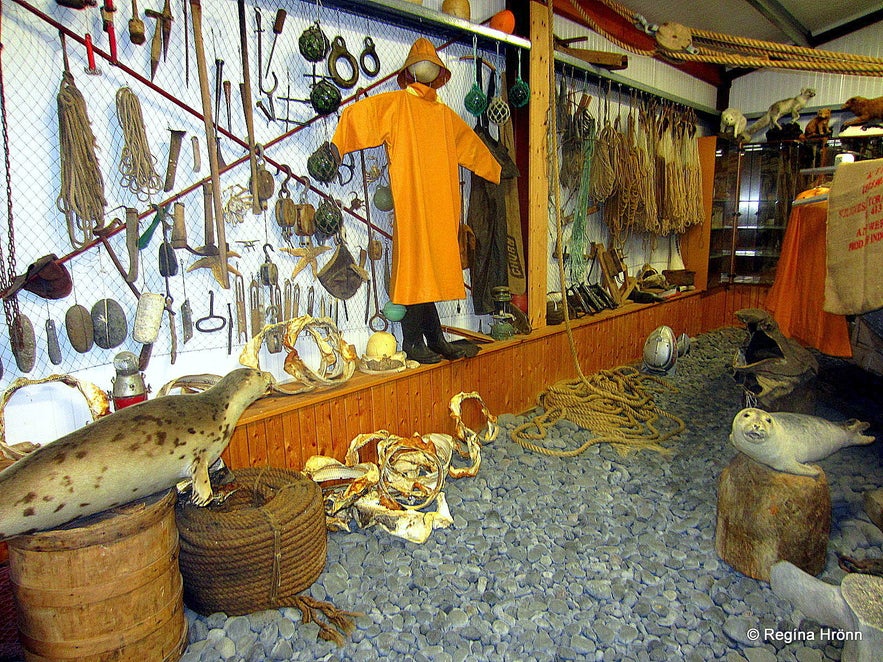
Inside the Shark Museum
Guests are invited to learn first-hand about the processing of shark meat at the museum and offered a taste of shark and stockfish.
If you have never tried shark before, then eat the shark and stockfish together in one bite, as that will make the taste of the shark a bit milder. I have seen grown men with tears running down their faces when they taste the shark, as it is so strong.
But you know what, when I was maybe 4-5 years old, I was crazy about fermented shark and would eat it out of a jar as I thought it was so yummy - but, it is an acquired taste, I guess ;)
Inside the Shark Museum
It is for sure a unique experience to visit the Shark Museum, we are used to men being afraid of sharks - here, on the other hand, you will find men who go hunt for sharks!
According to Landnáma - the Book of Settlement - Björn Ketilsson settled this area around the year 886 AD.
Björn was the brother of one of Iceland's most influential settler women, the Christian Auður djúpúðga, who settled at Hvammur in Dalir close by.
Their brother, Helgi bjóla settled in Kjalarnes in SW-Iceland, and their sister Þórunn hyrna settled in Eyjafjörður up north with her husband Helgi magri.
Here is an introductory video by Bjarnarhöfn:
Here you can see the location of the Shark Museum on the map.
After visiting the Shark Museum, let's return to road 54 and head in the direction of Stykkishólmur village, the capital of the Snæfellsnes peninsula.
We will pass Vatnaleið heath on our right-hand side and turn left on road 58, which is a 10 km road that takes you to the sacred Mt. Helgafell and a little further ahead to Stykkishólmur, which I will show you in my next travel-blog about the Magical Snæfellsnes peninsula - Part V.
Helgafell holy mountain and the three wishes
Mt. Helgafell
The historical Mt. Helgafell - the Sacred Hill is the next stop on my chronological tour of the Snæfellsnes peninsula.
The common belief amongst us locals is that if you can hike to the top of the mountain without looking back or uttering a word, you will get 3 wishes fulfilled.
Seeing that this travel-blog of mine is getting to be very long then I have added a special travel-blog about the holy Mt. Helgafell and the 3 wishes with loads of information about this special place and an additional chapter about the giantess and Helgafell.
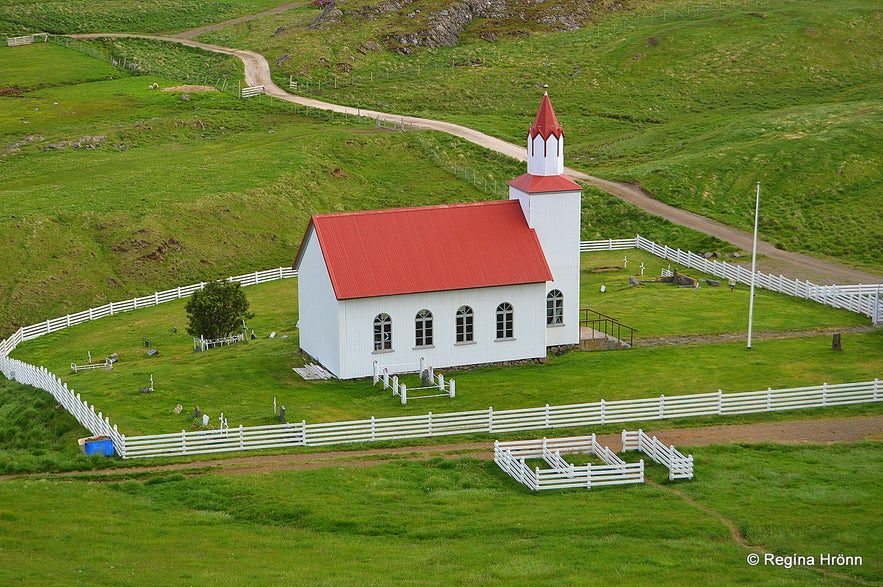
Helgafellskirkja church
Here you can see the location of Mt. Helgafell and the church on the map.
Next, we are going to visit the capital of the Snæfellsnes peninsula, Stykkishólmur town.
I have added the 5th travel-blog about Stykkishólmur town and what there is to see and do on the return trip back to Reykjavík, where we will be visiting my favourite hidden waterfall, the old Viking parliament Þórsnessþing, a giantess in a mountain pass, and end this trip by soaking in a hot geothermal pool.
The view from the top of Mt. Helgafell
I have written these 5 travel-blogs about the Snæfellsnes peninsula as there is just so much history and places of interest everywhere you look.
I have also added a lot of side blogs, so this has almost turned into a book :)
Here are links to all of the Snæfellsnes travel-blogs in this series:
The Magical Snæfellsnes peninsula - part I
The Magical Snæfellsnes peninsula - part II
The Magical Snæfellsnes peninsula - part III
The Magical Snæfellsnes peninsula - part IV
The Magical Snæfellsnes peninsula - part V
The Magical Snæfellsnes peninsula - Arnarstapi and Hellnar
I also created this map with the stops we made in this travel-blog.
Have a lovely time on the beautiful Snæfellsnes peninsula :)


